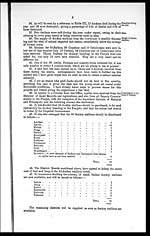Medicine - Veterinary > Civil Veterinary Departments > Annual administration report of the Civil Veterinary Department of India > 1900-1901 > Part I - Imperial report
(16) Page 4
Download files
Individual page:
Thumbnail gallery: Grid view | List view

4
28. The prices paid for imported horse and donkey stallions during the
year under review are as shown below:-
|
R |
a. |
p. |
|
|
Price of 8 horses imported from England £2,195-10-0 at |
32,932 |
8 |
0 |
|
£ s. d. |
|||
|
Price of 12 Catalonian donkeys at £50 each . 600 0 0 |
|||
|
Price of 10 Italian donkeys at £50 each . 500 0 0 |
|||
|
Price of 34 Cyprian donkeys at £27 each . 918 0 0 |
|||
|
2,018 0 0 |
|||
|
at 1s. 4d. per rupee . . . |
30,270 |
0 |
0 |
|
TOTAL . |
63,202 |
8 |
0 |
against R62,044 in 1899-1900, showing an increase of R1,158-8-0. This is
due to a larger number of donkey stallions having been imported than in the
previous year.
Maps.
29. As usual, maps will be found in the cover of this Report, showing the
breeding districts, the stands where stallions are located, and the number of
stallions at each stand.
II.-MULE BREEDING.
Number of donkey
stallions on the
Register.
30. A reference to Table I will show that whilst 439 donkey stallions were on
the Register at the beginning of the year, 460 were present at its close, of which
296 were up to 10 years of age, (vide Table II), 118 over 10 and up to 15 years,
and the remaining 46 were over 15 years old.
Number of donkey
stallions at work.
31. Table VII will show that 378 donkey stallions were employed against
347 in the previous year. If we exclude the 61 donkeys received during the year
under report, which were unacclimatized, we find that 21 donkeys were ineffec-
tive from sickness and other temporary causes.
Cost of feed and
keep.
32. The cost of feed and keep of donkey stallions, as shown in Table XII,
amounts to R183-4-3, against R179-13-0 in the previous year. The nominal
increase of R3-7-3 per donkey, per annum, is not worthy of comment.
Number and classes
of donkey stallions
received.
33. The number of donkey stallions received during the year, either by
importation or purchase, was as follows:—
|
Catalans . . . . . . . . . . |
12 |
|
Italians . . . . . .. . . . . |
10 |
|
Cyprians . . . . . .. . . . . |
34 |
|
Puujabis purchased in India . . . . |
5 |
|
TOTAL. |
61 |
Of the above number, six are for sale to various Native States, and the 5
Punjabis being at present too young for immediate work, will have to be kept
for a year. Fifteen will have to be allotted for donkey breeding in the Punjab,
28 will be issued for mule breeding in the several districts, and 7 will be handed
over to Lumberdars.
Prices paid for each
class of donkey.
34. The prices paid for each class of donkey stallion received, as communi-
cated to this Department, are as follows:—
|
Catalans. . . . . |
£50 plus transit charges. |
|
Italians . . . . . |
£50 „ „ „ |
|
Cyprians. . . . . |
£26-1-9 landed in Bombay. |
|
Punjabis. . . . . |
R97-0-0. |
Short note on each
class of stallions
35. The same Committee (vide paragraph 9 of this Report) which reported
on the horses, also saw the donkey stallions and I attach their remarks:—
Irish.—"Two only. We consider this class to be, 'very bad.' They are flat-sided, long, wanting in bone,
with crooked legs, and are in fact utterly unfit for breeding purposes.
Catalonians.—"A very unsatisfactory lot, flat-sided, cow-hocked, crooked legs. Unsuitable for stud pur-
poses.
Italians.—"Better than the preceding classes but inferior to previous years. Bad of the class and
generally small".
Cyprians.—"Compare unfavourably with former years. They are much too small and very weedy."
Set display mode to: Large image | Zoom image | Transcription
Images and transcriptions on this page, including medium image downloads, may be used under the Creative Commons Attribution 4.0 International Licence unless otherwise stated. ![]()
| India Papers > Medicine - Veterinary > Civil Veterinary Departments > Annual administration report of the Civil Veterinary Department of India > 1900-1901 > Imperial report > (16) Page 4 |
|---|
| Permanent URL | https://digital.nls.uk/75508005 |
|---|




